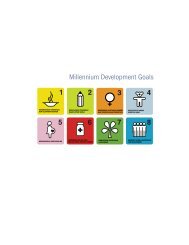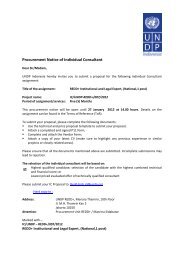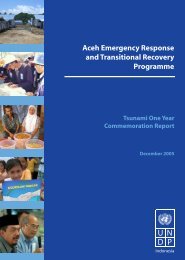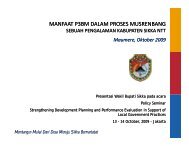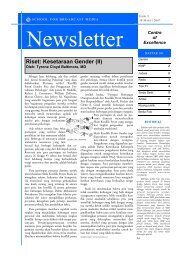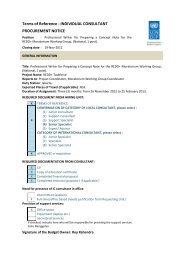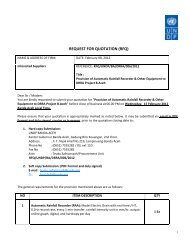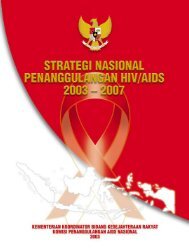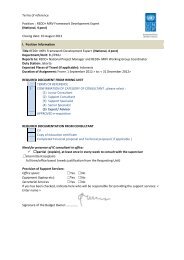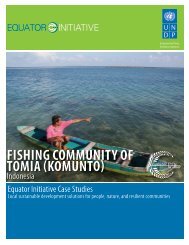Papua Needs Assessment - UNDP
Papua Needs Assessment - UNDP
Papua Needs Assessment - UNDP
Create successful ePaper yourself
Turn your PDF publications into a flip-book with our unique Google optimized e-Paper software.
5. <strong>Assessment</strong> of priorities<br />
The Grand Strategy identified the areas of health, education, livelihoods and infrastructure as four<br />
priority areas. The assessment of service provision in these areas must be considered in relation<br />
to the cross-cutting issues identified in the preceding sections, namely <strong>Papua</strong>’s social, cultural,<br />
economic, environmental and governance context.<br />
Although poor data integrity has been a major constraint in assessing service provision, the<br />
assessments by the participating universities and NGOs consistently reported that areas away<br />
from district (kecamatan) towns or centres, including the remote and isolated villages, have<br />
extremely limited access to services from government, such as health, education, livelihood /<br />
extension and appropriate infrastructure. Existing government services do not appear to be<br />
responsive to local conditions, particularly local needs and lifestyles, and are often not planned,<br />
budgeted or delivered according to cultural and geographical conditions. Thus they are not always<br />
used or valued by local people.<br />
Civil society organisations, particularly religious organisations, are active in providing basic services<br />
in many areas where government is not. However they face both financial and political constraints<br />
since access to partners based internationally is strictly controlled by certain central government<br />
agencies. PNA teams reported that in general, there is low trust and respect for the government<br />
as a service provider amongst many communities and services provided by civil society<br />
organisations are usually more valued and used. There are very few examples of successful,<br />
sustainable livelihood improvement initiatives in local communities, and agricultural, animal<br />
husbandry, and fisheries extension services are not considered to be effective.<br />
5.1 Education<br />
<strong>Papua</strong> has the lowest level of adult literacy in the nation,<br />
standing at 74.4% (Indonesia Human Development Report<br />
2004). Overall school attendance is low and the<br />
percentage of dropouts and illiteracy amongst pupils who<br />
leave primary school is also high. According to BPS data<br />
of 2000, only 82% of children in <strong>Papua</strong> attend primary<br />
school (SD), only 47% attend junior secondary school<br />
(SLTP), and only 19% attend senior secondary school<br />
(SMU). Dropouts from primary school are officially<br />
recorded at 6%, and from junior and senior high school<br />
the figure is 5%. The average reported dropout rate from<br />
primary schools is 3.4%, from junior high school is 15.6%<br />
and from senior high school is 24.6.% (PNA reports, 2005).<br />
The main causes of low attendance and high dropout rates<br />
in <strong>Papua</strong> include the following:<br />
Examples of variation in data<br />
reporting school participation*<br />
around <strong>Papua</strong><br />
Primary School:<br />
82% (BPS official for province)<br />
43% (Kab. Sarmi)<br />
93.5% (Kab. Paniai)<br />
Junior High School:<br />
47% (BPS official for province)<br />
25% (Kab. Jayawijaya)<br />
73.5% (Jayapura City)<br />
High School:<br />
19% (BPS official for province)<br />
52% (<strong>Papua</strong> wide)<br />
*% of eligible age enrolled, from<br />
PNA reports<br />
• Parents are disappointed with the quality of the<br />
education system;<br />
• The education system does not respond to local<br />
needs and circumstances, for example by teaching about the actual environments that<br />
students are familiar with and using languages that they understand;<br />
• The school year is not synchronised with cultivation or harvest cycles, which are when<br />
family and village activities require children’s assistance;<br />
21



